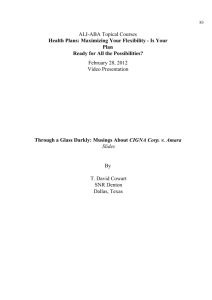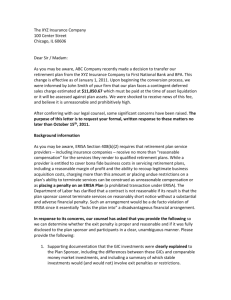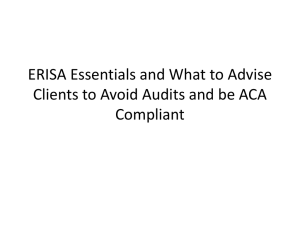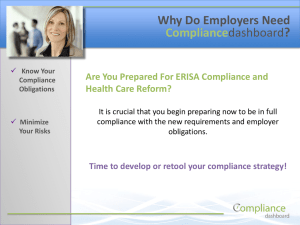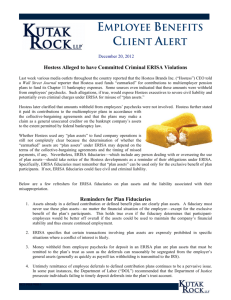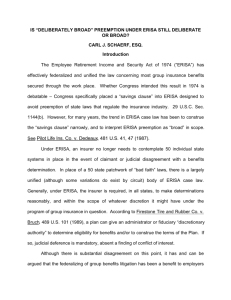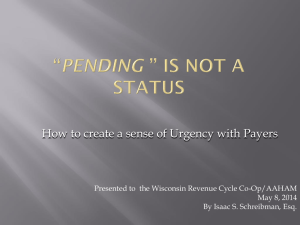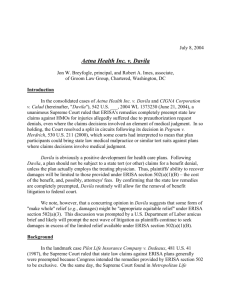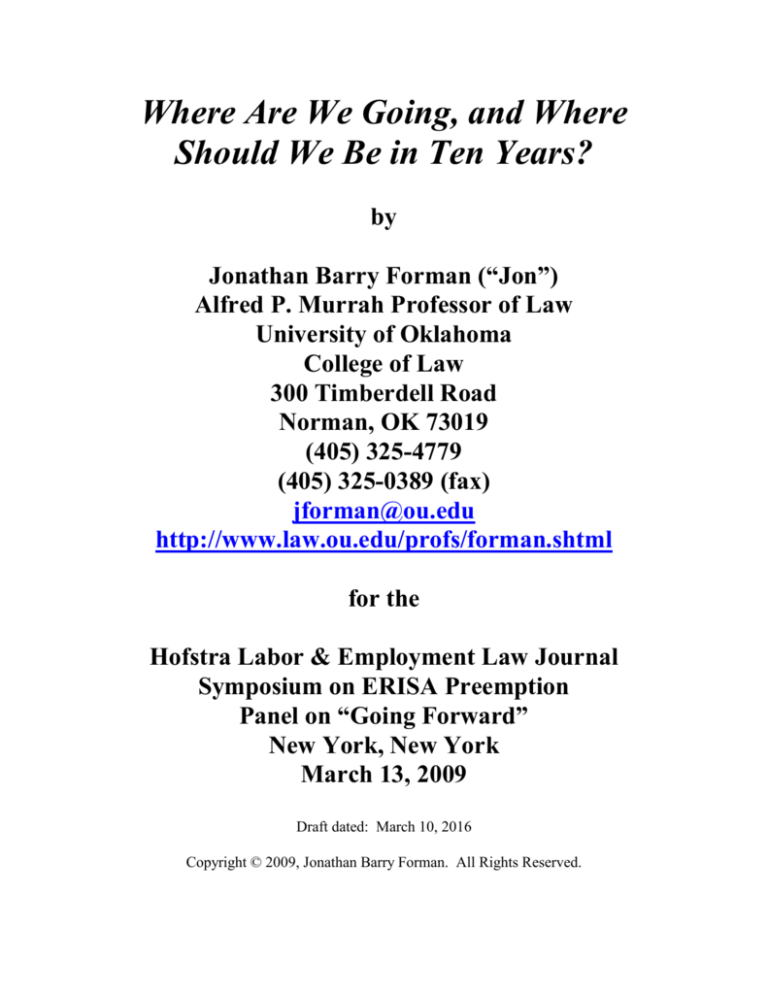
Where Are We Going, and Where
Should We Be in Ten Years?
by
Jonathan Barry Forman (“Jon”)
Alfred P. Murrah Professor of Law
University of Oklahoma
College of Law
300 Timberdell Road
Norman, OK 73019
(405) 325-4779
(405) 325-0389 (fax)
jforman@ou.edu
http://www.law.ou.edu/profs/forman.shtml
for the
Hofstra Labor & Employment Law Journal
Symposium on ERISA Preemption
Panel on “Going Forward”
New York, New York
March 13, 2009
Draft dated: March 10, 2016
Copyright © 2009, Jonathan Barry Forman. All Rights Reserved.
Abstract
Employee Retirement Income Security Act (ERISA) § 514 generally preempts state tort
and tort-like lawsuits against self-insured employment-based health care plans. ERISA’s
preemption rule also impedes state efforts to regulate and reform their health care systems.
ERISA preemption has also been a key factor in making America’s health care system
employment-based, unlike the health care systems in most other industrialized nations. This
year, as we renew our debate about how to reform our health care system, we should reconsider
whether and how to change the ERISA preemption rule.
At the outset, Part I of this article provides an overview of our current health care system.
Part II explains how the ERISA preemption rule influences the structure of our current health
care system. Finally, Part III considers the prospects for change. All in all, it seems unlikely that
we would relax the ERISA preemption rule to permit state tort and tort-like suits against selfinsured employment-based health care plans, but we might relax the preemption rule to allow
states some ability to experiment with approaches for regulating the provision of health care and
for providing universal coverage.
i
Table of Contents
I. OVERVIEW OF THE HEALTH CARE SYSTEM .............................................................................. 3
A. EMPLOYMENT-BASED HEALTH CARE COVERAGE .................................................................... 5
1. Tax Advantages .................................................................................................................... 7
2. Federal Preemption of State Laws ....................................................................................... 8
B. MEDICARE................................................................................................................................ 9
C. MEDICAID AND THE STATE CHILDREN’S HEALTH INSURANCE PROGRAM............................... 10
D. PROBLEMS WITH COST AND COVERAGE ................................................................................. 10
II. OVERVIEW OF ERISA PREEMPTION ...................................................................................... 11
A. ERISA PREEMPTS OF STATE LAW REMEDIES......................................................................... 14
B. ERISA IMPEDES STATE EFFORTS TO REGULATE AND REFORM THEIR HEALTH CARE SYSTEMS
................................................................................................................................................... 16
C. ERISA FAVORS EMPLOYMENT-BASED HEALTH CARE .......................................................... 18
III. PROSPECTS FOR REFORM ...................................................................................................... 18
A. HEALTH CARE REFORM GENERALLY ..................................................................................... 19
B. LITTLE CHANCE FOR EXPANDED REMEDIES ........................................................................... 21
C. SOME CHANCE THAT WE ALLOW THE STATES TO REGULATE PLANS ...................................... 23
D. SOME CHANCE OF MOVING AWAY FROM EMPLOYMENT-BASED COVERAGE ......................... 25
IV. CONCLUSION .......................................................................................................................... 27
ii
Where Are We Going, and Where Should We Be in Ten Years?
by Jonathan Barry Forman1
Employee Retirement Income Security Act (ERISA) § 514 generally preempts state tort
and tort-like lawsuits against self-insured employment-based health care plans.2 ERISA’s
preemption rule also impedes state efforts to regulate and reform their health care systems.
ERISA preemption has also been a key factor in making America’s health care system
employment-based, unlike the health care systems in most other industrialized nations. This
year, as we renew our debate about how to reform our health care system, we should reconsider
whether and how to change the ERISA preemption rule.
At the outset, Part I of this article provides an overview of our current health care system.
Part II explains how the ERISA preemption rule influences the structure of our current health
care system. Finally, Part III considers the prospects for change.
I. OVERVIEW OF THE HEALTH CARE SYSTEM
In 2006, national health expenditures totaled $2,106 billion, 16 percent of the gross
domestic product.3 The per capita health care expenditure was $7,026.4 The United States
currently spends about twice as much, per capita, on health care as other industrialized nations.5
The principal coverage mechanisms are employment-based health insurance, Medicare,
and Medicaid.6 In 2007, for example, 177.5 million Americans (59.3%) were covered by
1
Alfred P. Murrah Professor of Law, University of Oklahoma; B.A. 1973, Northwestern University; M.A.
(Psychology) 1975, University of Iowa; J.D. 1978, University of Michigan; M.A. (Economics) 1983, George
Washington University; Vice Chair of the Board of Trustees of the Oklahoma Public Employees Retirement System.
2
29 U.S.C. § 1144.
3
NAT’L CENTER FOR HEALTH STATISTICS, HEALTH, UNITED STATES 2008, 412 (table 124) (2009), available at
http://www.cdc.gov/nchs/data/hus/hus08.pdf (last visited Feb. 24, 2009) ($1,135 billion in private expenditures and
$970 billion in public expenditures [$705 billion federal and $265 billion from state and local governments]) .
4
Id. ($3,788 per capita in private expenditures and $3,238 in public expenditures).
employment-based private health insurance, 26.7 million (8.9%) bought their own private
insurance, 83.0 million (27.8%) had government health insurance (i.e., Medicare, Medicaid, or
military health care), and 45.6 million (15.3%) had no coverage.7
Most nonelderly Americans receive their health care coverage through employment-based
coverage provided to workers and their families. For example, Table 1 shows that 164.8 million
nonelderly Americans (62.9%) received their health care coverage through an employment-based
plan in 2007. Another 36.3 million (13.8%) were covered by Medicaid, and 7.1 million (2.7%)
were covered by Medicare that year. All in all, some 217.3 million nonelderly Americans
(82.9%) had health coverage in 2007, while 45.0 million (17.1%) had no coverage.
Table 1 Health Care Coverage of the Nonelderly, 20078
Source of Coverage
Millions
Total population
262.3
Employment-based coverage
164.8
Individually Purchased
17.1
Public
48.6
Medicare
7.1
Medicaid
36.3
Military health care
8.4
No health insurance
45.0
Percentage
100.0
62.9
6.5
18.5
2.7
13.8
3.2
17.1
The Medicare program provides nearly universal coverage for elderly Americans. For
example, Table 2 shows that 93.7 percent of the elderly were covered by Medicare in 2007, and
only 1.9 percent of the elderly were without health care coverage that year. Also, in addition to
5
Id. at 411(table 123); OECD FACTBOOK 2008: ECONOMIC, ENVIRONMENTAL, AND SOCIAL STATISTICS 211
(Organisation for Econ. Co-operation and Dev. ed., 2008), available at
http://lysander.sourceoecd.org/vl=3569513/cl=16/nw=1/rpsv/factbook (last visited Feb. 19, 2009).
6
U.S. CENSUS BUREAU, INCOME, POVERTY, AND HEALTH INSURANCE COVERAGE IN THE UNITED STATES: 2007
(2008), at 61.
7
Id.
8
Author’s computations from U.S. Census Bureau, Historical Health Insurance Tables, at Table HIA-2 (2008),
available at http://www.census.gov/hhes/www/hlthins/historic/index.html (last visited Feb. 19, 2009).
4
Medicare, many elderly Americans are covered by employment-based retiree health insurance
and/or individually-purchased Medigap policies.
Table 2 Health Care Coverage of the Elderly, 20079
Source of Coverage
Millions
Total population
36.8
Employment-based coverage
12.6
Individually Purchased
9.5
Public
34.5
Medicare
34.3
Medicaid
3.3
Military health care
2.6
No health insurance
0.7
Percentage
100.0
34.1
25.9
93.7
93.2
8.9
7.1
1.9
All in all, the federal government is heavily involved in providing health care assistance
through Medicare, Medicaid, the State Children’s Health Insurance Program (“SCHIP”),
veterans’ benefits, the exclusion for employment-based health care coverage, the deduction of
health care costs, federal employee benefits, and other mechanisms. In 2001, for example, the
federal government accounted for 32.9% ($406.6 billion) of all personal health spending, and
state and local governments picked up another 10.6% ($130.4 billion).10
A. EMPLOYMENT-BASED HEALTH CARE COVERAGE
Employers are not required to provide health care coverage for their workers.
Nevertheless, many employers provide coverage to attract and retain workers and to promote
worker health and productivity. For example, in 2007, 60 percent of employers offered health
9
Id.
COMMITTEE ON WAYS AND MEANS, 108TH CONG., 2004 GREEN BOOK: BACKGROUND MATERIAL AND DATA ON
PROGRAMS WITHIN THE JURISDICTION OF THE COMMITTEE ON WAYS AND MEANS, Appendix C-1, at Table C-9
(Comm. Print 2004), available at http://waysandmeans.house.gov/Documents.asp?section=813 (last visited Feb. 19,
2009).
10
5
care coverage to their workers,11 and surveys show that health insurance is the fringe benefit that
is most valued by workers and their families.12 In 2008, the average annual premiums for
employment-based health insurance were $4,704 for single coverage and $12,680 for family
coverage.13 Also of note, inflation-adjusted family health insurance premiums have increased by
58 percent since 2000, while real hourly earnings have increased just 3 percent over that period.14
While 62.2 percent of the nonelderly population had employment-based health care
coverage in 2007, coverage also varies dramatically depending on such factors as firm size,
industry, and earnings.15 For example, while 79.7 percent of employees at large private firms
(1,000 or more employees) had health care coverage from their employers in 2007, only 58.7
percent of workers at firms with 10 to 24 workers received health care coverage from their
employers that year.16 Similarly, individuals typically have to work full time to obtain a job with
health insurance. In 2007, for example, 72.8 percent of nonelderly full-year, full-time workers
had employment-based health care coverage, compared with just 35.1 percent of part-time, partyear workers.17
11
Paul Fronstin, Sources of Health Insurance and Characteristics of the Uninsured: Analysis of the March 2008
Current Population Survey 8 (Employee Benefit Research Institute Issue Brief No. 321, 2008), available at
http://www.ebri.org/pdf/briefspdf/EBRI_IB_09a-2008.pdf (last visited March 1, 2009).
12
See, e.g., National Business Group on Health, Most Workers Satisfied with Health Care Benefits, National
Business Group on Health Survey Finds (April 12, 2007), available at
http://www.businessgrouphealth.org/pressrelease.cfm?ID=87 (last visited Feb. 26, 2009) (75 percent of workers
value the health plan as the most important benefit).
13
KAISER FAMILY FOUNDATION AND HEALTH RESEARCH & EDUCATIONAL TRUST, EMPLOYER HEALTH BENEFITS
2008 ANNUAL SURVEY 1 (2008). For singles, the employee contribution averaged $721, and the employer
contribution averaged $3,983; for families, the employee contribution averaged $3,354, and the employer
contribution averaged $9,325.
14
OFFICE OF MANAGEMENT AND THE BUDGET, A NEW ERA OF RESPONSIBILITY: RENEWING AMERICA’S PROMISE
(2009), at 13 (figure 11).
15
Fronstin, supra note 11, at 1.
16
Fronstin, supra note 11, at 12 (figure 11).
17
Fronstin, supra note 11, at 10 (figure 9).
6
Before World War II, relatively few workers had health insurance coverage.18 When
wages were frozen during World War II, some employers began offering health insurance as a
way of getting around government wage controls. Union support of health insurance and
favorable tax treatment were also significant factors in the expansion of the employment-based
health care system. Employers also find that they can purchase group health insurance coverage
at better rates than individual employees.
1. Tax Advantages
The tax advantages associated with employment-based health care plans are another
reason employment-based plans dominate the provision of health care to working-age Americans
and their families. Workers generally must pay income tax on the compensation that they receive
from an employer. To encourage employment-based health care coverage, however, employer
contributions to health care plans are excluded from income.19 Also, many employers provide
cafeteria and flexible spending plans that enable employees to shelter their share of premiums
and other health care costs.20 Also of note, under the health care continuation rules provided by
the Consolidated Omnibus Budget Reconciliation Act of 1986 (COBRA), former employees of
firms with 20 or more workers are typically entitled to continue their health care coverage for
awhile after leaving their firms,21 and some employers also provide health care coverage for their
retired workers.22
18
See, e.g., JONATHAN BARRY FORMAN, MAKING AMERICA WORK 246 (2006).
I.R.C. § 106.
20
I.R.C. § 125.
21
ERISA §§ 601 et seq., 29 U.S.C. §§ 1161 et seq.
22
See, e.g., Paul Fronstin, The Impact of the Erosion of Retiree Health Benefits on Workers and Retirees (Employee
Benefit Research Institute Issue Brief No. 279, 2005), available at http://www.ebri.org/pdf/briefspdf/0305ib.pdf (last
visited, March 1, 2009).
19
7
Self-employed individuals are also permitted to deduct 100 percent of their health
insurance costs,23 but there is no similar tax benefit for employees whose employers do not
provide health care coverage.
The tax savings from being able to shelter $5,000 or $10,000 a year per family from the
income tax makes employment-based health care coverage much more valuable than taxable cash
compensation. For example, an employee in the 25 percent income tax rate bracket would not be
taxed if her employer contributed $10,000 on her behalf to an employment-based health care plan
for her family. On the other hand, that employee would have to pay $2,500 in income tax on the
receipt of $10,000 in cash compensation ($2,500 = $10,000 × 25 percent), leaving just $7,500
after tax—hardly enough to buy a family health insurance policy in the individual market. All in
all, the U.S. Treasury loses over $150 billion a year because of the exclusion of employer
contributions for health care and another $5 billion a year because of the deduction for selfemployed health care premiums.24
2. Federal Preemption of State Laws
Another reason employment-based plans dominate the provision of health care to
working-age Americans and their families is that federal law generally makes it extremely
difficult for states to experiment with more universal systems for the provision of health care
benefits. As more fully explained in Part II below, the Employee Retirement Income Security
Act of 1974 (ERISA) preempts “any and all State laws insofar . . . as they relate to any employee
23
I.R.C. § 162(l).
EXECUTIVE OFFICE OF THE PRESIDENT AND OFFICE OF MANAGEMENT AND BUDGET, ANALYTICAL PERSPECTIVES,
BUDGET OF THE UNITED STATES GOVERNMENT, FISCAL YEAR 2009 (2010), at 288, 290 (table 19-1).
24
8
benefit plan.”25 Although ERISA was largely intended to federalize pension law and had little to
say about health care plans, this preemption rule enables employers to avoid state regulation by
setting up “self-insured” plans. State governments can dictate how health insurance plans work,
but they are prevented from telling self-insured employment-based plans what to do. The
resulting inability of states to regulate all health care plans makes it difficult for the states to act
as “laboratories of democracy” that could experiment with the whole range of approaches for
expanding coverage.26
B. MEDICARE
The Medicare program provides nearly universal coverage for elderly Americans and for
certain disabled persons.27 Medicare Part A provides hospital insurance coverage for almost
everyone over age 65 and for certain disabled persons under age 65. Medicare Part B is a
voluntary program that generally pays 80 percent of the doctor bills and laboratory tests for
elderly and disabled individuals who choose to enroll and pay the monthly premium ($96.40 in
2009).28 In 2007, 44.1 million people were covered by Medicare, and total program outlays that
year were $431.5 billion.29
25
ERISA § 514(a), 29 U.S.C. § 1144(a).
See, e.g., Jon Forman, Uncle Sam should let the states be laboratories for health care reform, WASHINGTON
EXAMINER, March 2, 2007, at 21.
27
See, e.g., U.S. DEPARTMENT OF HEALTH AND HUMAN SERVICES, CENTERS FOR MEDICARE & MEDICAID SERVICES,
MEDICARE & YOU 2009 (2008), http://www.medicare.gov/Publications/Pubs/pdf/10050.pdf (last visited March 1,
2009).
28
U.S. Department of Health and Human Services, Medicare premiums and coinsurance rates for 2009, available at
http://www.medicare.gov/default.asp (last visited Feb. 26, 2009).
29
BOARDS OF TRUSTEES OF THE FEDERAL HOSPITAL INSURANCE AND FEDERAL SUPPLEMENTARY MEDICAL
INSURANCE TRUST FUNDS, 2006 ANNUAL REPORT OF THE BOARDS OF TRUSTEES OF THE FEDERAL HOSPITAL
INSURANCE AND FEDERAL SUPPLEMENTARY MEDICAL INSURANCE TRUST FUNDS 5 (table II.B1) (2008). See also
OFFICE OF MANAGEMENT AND THE BUDGET, A NEW ERA OF RESPONSIBILITY: RENEWING AMERICA’S PROMISE, supra
note 14, at 117 (table S-3) (projecting a $453 billion expenditure on Medicare in fiscal year 2010).
26
9
C. MEDICAID AND THE STATE CHILDREN’S HEALTH INSURANCE PROGRAM
Medicaid is a federal-state matching entitlement program that provides medical assistance
for needy persons who are elderly, blind, disabled, members of families with dependent children,
and certain other pregnant women and children.30 The program is means-tested; that is, eligible
recipients must have relatively low income and relatively few assets. The program is financed by
general revenues from federal and state governments. States design and administer their
programs within federal guidelines, and the federal government reimburses most of their costs.
In addition, the State Children’s Health Insurance program (SCHIP) was enacted by Congress in
1997 to expand health care coverage for children in low-income families.31 The program
provides block grants to states in order to provide health care benefits for uninsured children,
ineligible for Medicaid, whose families have low incomes. In 2007, 49.1 million people were
covered by Medicaid (including SCHIP), and total program outlays that year were $333.2
billion.32
D. PROBLEMS WITH COST AND COVERAGE
Far and away the biggest problem with the American health care system has to do with
coverage. As noted above, in 2007, 45.6 million Americans (15.3%) had no health care
coverage.33 Clusters of individuals that tend to lack coverage include employees of small
30
See, e.g., U.S. Department of Health and Human Services, Medicaid Program—General Information, available at
http://www.cms.hhs.gov/MedicaidGenInfo (last visited Feb. 26, 2009).
31
Id.
32
Office of the Actuary, Centers for Medicare & Medicaid Services, U.S. Department of Health & Human Services,
2008 Actuarial Report on the Financial Outlook for Medicaid iii (2008), available at
http://www.cms.hhs.gov/ActuarialStudies/downloads/MedicaidReport2008.pdf (last visited March 1, 2009) ($190.6
billion [57 percent] federal, and $142.6 billion [43 percent] state). See also OFFICE OF MANAGEMENT AND THE
BUDGET, A NEW ERA OF RESPONSIBILITY: RENEWING AMERICA’S PROMISE, supra note 14, at 117 (table S-3)
(projecting a $259 billion federal expenditure on Medicaid in fiscal year 2010).
33
See supra note 6 and accompanying text.
10
business, workers who lose their jobs, workers who decline employer coverage, low-income
parents, low-income childless adults, the near elderly, young adults, children, and immigrants.34
Part and parcel of the growing coverage problem is the fact that health care costs are
spiraling out of control. Spending on health care will account for about 16 percent of gross
domestic product in 2009 and is projected to reach 20 percent of GDP by 2017.35 These everincreasing costs have put pressure on employers, employees, and governments. For example,
annual per capita health care expenditures are expected to increase from $8,300 this year to
around $13,000 in 2017.36 Of particular concern, the administrative costs associated with the
American health care system are “enormous,” with estimates ranging anywhere from $90 billion
to $294 billion a year.37 Every health care plan has a different set of rules, and it seems like
every insurance company, every employer, every hospital, and every doctor has a different set of
claim forms.
II. OVERVIEW OF ERISA PREEMPTION
Under the U. S. Constitution’s Supremacy Clause, federal laws implicitly preempt and
supersede any inconsistent state laws.38 In the employee benefits area, Congress chose to make
this preemption explicit. Accordingly, the Employee Retirement Income Security Act of 1974
(ERISA) preempts “any and all State laws insofar . . . as they relate to any employee benefit
34
STAN DORN, TOWARDS INCREMENTAL PROGRESS: KEY FACTS ABOUT GROUPS OF UNINSURED (2004), available at
http://www.esresearch.org/newsletter/facts_uninsured.pdf (last visited March 1, 2009).
35
OFFICE OF MANAGEMENT AND THE BUDGET, A NEW ERA OF RESPONSIBILITY: RENEWING AMERICA’S PROMISE,
supra note 14, at 11.
36
Expanding Health Insurance Coverage and Controlling Costs for Health Care (testimony of Douglas W.
Elmendorf, Director, Congressional Budget Office before the Senate Committee on the Budget, Feb. 10, 2009), at 8.
37
LEIF WELLINGTON HAASE, A NEW DEAL FOR HEALTH: HOW TO COVER EVERYONE AND GET MEDICAL COSTS
UNDER CONTROL 25 (2005), available at http://www.tcf.org/Publications/HealthCare/newdealhealth.pdf (last visited
March 1, 2009).
11
plan.”39 In general, the United States Supreme Court has given this explicit preemption clause an
expansive interpretation.40
A major exception is provided in the so-called “insurance savings clause” which provides
that “nothing in this title shall be construed to exempt or relive any person from any law of any
State which regulates insurance, banking, or securities.”41 The insurance exception is itself
subject to an important exception under the so-called “deemer clause” which provides that
employee benefit plans are not to be considered insurance for purposes of the insurance savings
clause.42
Altogether, the net effect of the broad preemption provision and the insurance and deemer
provisions is known as semi-preemption.43 States can pass laws that regulate insurance, but they
cannot regulate self-insured employee benefit plans. In the health arena, this semi-preemption
policy has been enormously important. Here’s how it works.
Basically, if an employer chooses to offer health care coverage for its employers, the
employer can go to an insurance company and buy a group health policy. At its simplest, the
employer pays premiums to the insurance company, and in exchange, the insurance company
pays the health care bills of the employees. States are free to regulate the health insurance
38
U.S. CONSTITUTION, ARTICLE VI, § 2; JOHN H. LANGBEIN, SUSAN J. STABILE, AND BRUCE A. WOLK, PENSION AND
EMPLOYEE BENEFIT LAW 758 (4th ed. 2006)
39
ERISA § 514(a), 29 U.S.C. § 1144(a).
40
See, e.g., Alessi v. Raybestos-Manhattan, Inc., 451 U.S. 504 (1981) (preempting a New Jersey law that undertook
to regulate how an employee benefit plan computed benefits); Shaw v. Delta Air Lines, 463 U.S. 85 (1983)
(preempting a New York law that forbade discrimination in employee benefit plans on the basis of pregnancy).
41
ERISA § 514(b)(2)(A), 29 U.S.C. § 1144(b)(2)(A).
42
ERISA § 514(b)(2)(B), 29 U.S.C. § 1144(b)(2)(B).
43
Daniel M. Fox & Daniel C. Schaffer, Semi-Preemption in ERISA: Legislative Process and Health Policy, 7
AMERICAN J. TAX POLICY 47 (1988). See also William Pierron & Paul Fronstin, ERISA Pre-emption: Implications
12
policies that regulate employees that live within their borders, and most states have extensive
insurance laws that govern the kind of policies that can be written and offer protections for the
insured employers and for employee-beneficiaries. A state could, for example, require health
insurance policies sold in its state to pay for psychiatric or chiropractic services, or for
acupuncture services.44
On the other hand, because of the deemer clause, employers that elect to self-insure can
avoid those state-mandated benefits. Under a self-insured plan, the employer bears the
responsibility for paying benefits. Typically, the employer hires an insurance company to
actually administer the health care plan, in which case the insurance company is called a thirdparty administrator.45 The employer pays for those administrative services and provides the
funds needed to pay hospitals, doctors, and other health care providers. These payments are not
premiums for insurance, however, and state laws governing insurance do not apply to these
plans.46 In 2008, 55 percent of covered employees were in self-funded plans.47 Needless to say,
from the employee-beneficiary standpoint, these self-insured plans feel just like insured plans.
for Health Reform and Coverage (Employee Benefit Research Institute, Issue Brief No. 314, 2008), available at
http://www.ebri.org/pdf/briefspdf/EBRI_IB_02a-20082.pdf (last visited March 1, 2009).
44
See, e.g., Metropolitan Life Ins. Co. v. Massachusetts, 471 U.S. 724 (1985) (upholding a Massachusetts law
requiring insurers to provide for psychiatric services).
45
These third party administrators develop networks of providers, negotiate payment rates, process claims, and so
forth. CONGRESSIONAL BUDGET OFFICE, KEY ISSUES IN ANALYZING MAJOR HEALTH INSURANCE PROPOSALS (2008),
at 6 (box 1-1).
46
See, e.g., FMC Corp. v. Holliday, 498 U.S. 52 (1990) (holding that a self-insured plan was not subject to a
Pennsylvania anti-subrogation law). To be sure, many employers purchase so-called “stop-loss” insurance, which
protects the employer from the risk that actual health care costs for its employees exceed some budgeted-for
specified threshold. See, e.g., LANGBEIN ET AL., supra note 38, at 806-07.
47
KAISER FAMILY FOUNDATION AND HEALTH RESEARCH & EDUCATIONAL TRUST, supra note 13, at 155. See also
Pierron & Fronstin, supra note 43; CONGRESSIONAL BUDGET OFFICE, KEY ISSUES IN ANALYZING MAJOR HEALTH
INSURANCE PROPOSALS, supra note 45, at 6 (box 1-1).
13
By design, ERISA’s semi-preemption policy ensured that large employers and large
unions could provide uniform benefit plans to their workers around the country and did not have
to modify their plans to satisfy the parochial demands of the various states.48 Implicitly,
however, this grand compromise between business and labor took away the ability of states to
fully regulate the provision of health care within their borders. Plans that self-insure are exempt
from state benefit mandates and insurance regulation. Meanwhile, the federal government has
done little since 1974 to regulate health care in any sort of comprehensive way. Not surprisingly,
after 35 years of ERISA-sanctioned neglect, we are far from achieving universal health care
coverage, health care costs are spiraling out of control, and nobody is particularly happy with the
current system.
More specifically, ERISA’s semi-preemption policy has manifested itself in three
principal ways. First, ERISA preempts virtually all state law remedies for wronged beneficiaries
of employment-based health care plans. Second, ERISA impedes state efforts to regulate and
reform the health care systems that operate within their borders. Third, the ERISA and Internal
Revenue Code advantages for employment-based health care plans have all but made it all but
impossible for alternative health care plans to develop. These are discussed in turn.
A. ERISA PREEMPTS OF STATE LAW REMEDIES
First, ERISA severely limits the likelihood and amount of recoveries that are available to
beneficiaries of employee benefit plans. In that regard, ERISA generally preempts virtually all
state tort and tort-related causes of action against employee benefit plans. According to the
48
See, e.g., Michael S. Gordon, The History of ERISA’s Preemption Provision and Its Bearing on the Current
Debate over Health Care Reform, in Health Care Reform: Managed Competition and Beyond 28-30 (Employee
14
Supreme Court, ERISA “provides a comprehensive civil enforcement scheme that represents a
careful balancing of the need for prompt and fair claims settlement procedures against the public
interest in encouraging the formation of employee benefit plans.”49 To be sure, ERISA permits
plan participants and beneficiaries “to recover benefits due him under the terms of the plan,” “to
enforce his rights under the terms of the plan,” and to obtain “appropriate equitable relief.”50 But
participants and beneficiaries cannot recover consequential or punitive damages. In short, you
can sue to make the plan provide your benefits, but you cannot recover any extra damages for any
wrongful denial of benefits, nor are you likely to get attorney fees.51
Pertinent here, traditional medical malpractice tort suits against doctors and other
practitioners can survive preemption, but the employee benefit plan virtually always exempt from
such suits.52 Also of note, beneficiaries are required to exhaust their administrative remedies
before bringing a suit against an employee benefit plan, the court will usually only overturn the
plan administrator’s decision if it was arbitrary and capricious, and it is virtually impossible to
get a jury trial.
Of note, recent Supreme Court decisions have backed away from the Court’s earlier
expansive view of the “relate to an employee benefit plan” preemption language in ERISA §
514(a). For example, in New York State Conference of Blue Cross & Blue Shield Plans v.
Benefit Research Institute Issue Brief No. 135, 1993), at 28-30 available at
http://www.ebri.org/pdf/briefspdf/0393ib.pdf (last visited March 10, 2009).
49
Pilot Life Ins. Co. v. Dedeaux, 481 U.S. 41, 54 (1987) (preempting a state cause of action based on the tort of bad
faith denial). In Massachusetts Mutual Life Ins. Co. v. Russell, 473 U.S., 134, 146 (1985), the Supreme Court noted
that ERISA has a “comprehensive and reticulated” remedial scheme. See also Metropolitan Life Ins. Co. v. Taylor,
481 U.S. 58 (1987) (preempting state causes of action that fell within ERISA § 502(a)(1)(B)).
50
ERISA § 502(a)(1)(B), (3), 29 U.S.C. § 1132(a)(1)(B), (3).
51
In Alessis v. Raybestos-Manhattan, Inc., 451 U.S. 504, 515 (1981), the Supreme Court notes that ERISA is
concerned with both benefiting employees and controlling costs.
15
Travelers Ins. Co., the Supreme Court refused to preempt a New York law that imposes hospital
surcharges which had an adverse impact on self-insured plans.53
The Supreme Court has also expanded the role of the “insurance savings” clause in
ERISA § 514(b)(2)(A). In Rush Prudential HMO v. Moran, the Court held that ERISA did not
preempt Illinois’ Health Maintenance Organizations Act which gave HMO beneficiaries the right
to independent review of benefit denials: the court found that those independent reviews did not
conflict with ERISA’s remedial scheme.54 On the other hand, in Aetna Health Inc., v. Davila, the
Supreme Court reiterated that “a state law that can arguably be characterized as ‘regulating
insurance’ will be preempted if it provides a separate vehicle to assert a claim for benefits outside
of, or in addition to, ERISA’s remedial scheme.”55
B. ERISA IMPEDES STATE EFFORTS TO REGULATE AND REFORM THEIR
HEALTH CARE SYSTEMS
Second, ERISA impedes state efforts to regulate and reform their health care systems.
Because of ERISA’s policy of semi-preemption, states are generally prohibited from imposing
benefit mandates or otherwise regulating self-insured employment-based heath care plans. The
state of Hawaii enacted its Prepaid Health Care system in 1974, prior to the enactment of
ERISA.56 That system requires all employers in Hawaii to offer employees basic health care
52
See, e.g., LANGBEIN ET AL., supra note 38, at 824-826; see also Pegram v. Herdich, 530 U.S. 211 (2000).
514 U.S. 645 (1995). See also DeBueno v. NYSA-ILA Medical Services Fund, 520 U.S. 606 (1997) (refusing to
preempt a tax of general applicability on medical providers).
54
536 U.S. 355 (2002). Similarly, in Kentucky Association of Health Plans v. Miller, 538 U.S. 329 (2003), the
Supreme Court refused to preempt a Kentucky “any willing provider” law that required health insurers and managed
care organizations to reimburse all licensed physicians and other health professionals as long as they were willing
and qualified to participate in the insurer’s network.
55
542 U.S. 200, 217-18 (2004)
56
CONGRESSIONAL BUDGET OFFICE, KEY ISSUES IN ANALYZING MAJOR HEALTH INSURANCE PROPOSALS, supra note
45, at 50-51(box 2-3).
53
16
coverage, and Congress granted Hawaii a waiver from the ERISA provisions that would have
otherwise interfered with its mandate.
More recently, Maryland recently enacted legislation that would have required companies
with at least 10,000 employees (i.e., Wal-Mart) to spend at least 8 percent of payroll on health
care or give the difference to the state.57 In 2007, however, the Court of Appeals for the Fourth
Circuit struck that legislation down, ruling that it was preempted by ERISA.58
Massachusetts recently enacted a comprehensive health care law with individual
mandates and employer mandates. 59 The new law requires every resident over the age of 18 to
have health insurance (an individual mandate) and requires every employer with 11 or more
employees to offer health insurance and offer a “cafeteria plan” so that employees can elect to
exclude their premiums from income and payroll taxes (an employer mandate). Employers must
either “pay or play”; that is, they must either make a “fair and reasonable contribution” to their
employees’ health insurance or pay the state of Massachusetts up to $295 per worker per year.
While the Massachusetts law seems like a perfectly reasonable way to promote universal health
care coverage, I believe that the employer mandate is preempted by ERISA.60
Similarly, the City of San Francisco recently adopted a mandated health benefit
ordinance. The ordinance was immediately challenged by employers as preempted by ERISA,
57
See, e.g., Editorial, Beating Up on Wal-Mart, WASH. POST, Jan. 12, 2006, at A20; Jon O. Shimabukuro & Jennifer
Staman, Legal Inssures Relating to State Health Care Regulation: ERISA Preemption and Fair Share Laws
(Congressional Research Service Report No. RL34637, August 26, 2008); Groom Law Group, Background
Memorandum on State Laws and ERISA Preemption (American Benefits Council 2007), available at
http://www.americanbenefitscouncil.com/documents/background_memo_on_erisa_preemption.pdf.
58
Retail Indus. Leaders Ass’n v. Fielder, 475 F.3d 180 (4 th Cir. 2007).
59
CONGRESSIONAL BUDGET OFFICE, KEY ISSUES IN ANALYZING MAJOR HEALTH INSURANCE PROPOSALS, supra note
45, at 50-51(box 2-3).
17
but the Court of Appeals for the Ninth Circuit has so far rejected claims that the ordinance is
preempted by ERISA.61 As there is now a split in the circuits, the issue is ripe for consideration
by the Supreme Court.
C. ERISA FAVORS EMPLOYMENT-BASED HEALTH CARE
Third, ERISA and the Internal Revenue Code favor employment-based health care plans
over other types of plans. ERISA governs employee benefit plans and provides, inter alia,
preemption “protections” for employee benefit plans. Similarly, the Internal Revenue Code
provides extremely valuable tax benefits for employment-based health care plans. Group health
insurance rates are also much lower than individual rates. The bottom line is that there are
tremendous price advantages for workers who get their health care coverage through
employment-based plans. Moreover, since the tax and preemption provisions apply only to
employee benefit plans, community groups and associations cannot offer group health care
coverage at rates that are anywhere near as low as what employment-based plans can.
III. PROSPECTS FOR REFORM
This section considers how Congressional efforts in the coming years might impact
ERISA’s preemption rule. Other articles in this symposium offer suggestions about how to
persuade the Supreme Court to back away from its usual expansive readings of ERISA’s
preemption clause and the deemer clause.62 I view it as unlikely that the Supreme Court will
reverse its expansive reading of ERISA preemption at this late date unless Congress actually
60
To the same effect, see Edward A. Zelinsky, The New Massachusetts Health Law: Preemption and
Experimentation, 49 WM. & MARY L. REV. 229, 276-287 (2007).
61
Golden Gate Rest. Ass’n v. City & County of San Francisco, 546 F.3d 639 (9 th Cir. 2008). See also Edward A.
Zelinsky, Employer Mandates and ERISA Preemption: A Critique of Golden Gate Restaurant Association v. San
Francisco, 47 STATE TAX NOTES 603 (Nov. 24, 2008).
18
amends ERISA. That said, I believe that Congressional efforts to reform the health care system
are unlikely to result in much change to the current semi-preemption rule in ERISA.63
A. HEALTH CARE REFORM GENERALLY
To be sure, President Barack Obama and Congress both seem committed to addressing
the current health care systems twin problems of coverage and cost. We are just now getting the
details of the President Barack Obama’a health care proposal,64 and we are a long way from
having any kind of comprehensive health care plan get through Congress. Still, I think we can
already begin to see the direction that health care reform will take.
While universal coverage is almost certainly our ultimate goal, I believe that we will get
there incrementally, for example, by designing and expanding health care programs for particular
groups of the uninsured.65 For example, The Children’s Health Insurance Program
Reauthorization Act of 2009 (CHIP) expands SCHIP health coverage to provide coverage to
children with family incomes up to 300 percent of the federal poverty line.66 The new law also
62
See, e.g., Paul M. Secunda, Sorry, No Remedy: Intersectionality and the Grand Irony of ERISA, 26 HOFSTRA
LAB. & EMP. L. J. ___ (forthcoming 2009).
63
To the same effect, see Health Care Reform: AARP Official Sees Health Reform in ’09, With ERISA Preemption
Likely to Remain, 36 (2) BNA PENSION & BENEFITS REPORTER 72 (Jan. 13, 2009) (comments of AARP policy
director John Rother).
64
See, e.g., The White House, The Agenda—Health Care, http://www.whitehouse.gov/agenda/health_care; OFFICE
OF MANAGEMENT AND THE BUDGET, supra note 14, at 27-30.
65
Pertinent here, for example, the Congressional Budget Office recently released a major report outlining some 115
budget options related to the financing and delivery of health care, none of which has to do with preemption. See
CONGRESSIONAL BUDGET OFFICE, BUDGET OPTIONS VOLUME I HEALTH CARE (2008).
66
Pub. L. No. 111-3 (Feb. 4, 2009); U.S. Committee on Finance, The Children’s Health Insurance Program
Reauthorization Act: Frequently Asked Questions (2009), available at
http://finance.senate.gov/sitepages/2009%20CHIPRA.html (last visited Feb. 19, 2009). See also Congressional
Budget Office, Cost Estimate H.R.2 Children’s Health Insurance Program Reauthorization Act of 2009 (2009),
available at http://www.cbo.gov/ftpdocs/99xx/doc9985/hr2paygo.pdf (last visited Feb. 19, 2009). Of note, the
Children’s Health Insurance Program Reauthorization Act amended ERISA to better coordinate the CHIP provisions
with employment-based health care plans. See, e.g., Michael W. Wyand & Florence Olsen, Expansion of CHIP
Program Amends ERISA To Promote Coordination with Employer Plans, 36 (6) BNA PENSION & BENEFITS
REPORTER 299 (Feb. 10, 2009).
19
allows states to provide premium assistance for employment-based group health coverage that is
elected for SCHIP-eligible children. Similarly, the American Recovery and Reinvestment Act of
2009 helps unemployed workers keep their employment-based coverage by providing a 65%
subsidy for health insurance premiums for up to 9 months.67
Along the same lines, we could extend COBRA health care continuation coverage to 36
or more months or until eligibility for Medicare at age 65.68 Another approach would be to
expand Medicaid or develop other programs to ensure seamless coverage for individuals making
the transition from welfare to work.69 The government might also be able to expand coverage for
employees of small businesses by providing tax credits to employers that provide health
insurance to their employees.70
In the long run, we could achieve nearly universal coverage if we use two basic
approaches. First, we would need to subsidize health insurance premiums, either through the tax
system or through spending programs. Second, we would need to impose health insurance
mandates. Certainly, we would need an individual mandate, requiring individuals to secure
coverage from their employers or some other source and subjecting those individuals to financial
penalties if they do not secure coverage. It might also make sense to have employer mandates.
67
Pub. L. No. 111-5 (Feb. 17, 2009); U.S. Senate Finance Committee, The American Recovery and Reinvestment
Act of 2009: Full Summary of Provisions from Senate Finance, House Ways & Means Committees 16 (2009),
available at http://finance.senate.gov/press/Bpress/2009press/prb021209.pdf (last visited Feb. 19, 2009).
68
Len M. Nichols, Policy Options for Filling Gaps in the Health Insurance Coverage of Older Workers and Retirees,
in ENSURING HEALTH AND INCOME SECURITY FOR AN AGING WORKFORCE 451(Peter P. Budetti, Richard V.
Burkhauser, Janice M. Gregory, and H. Allan Hunt eds., 2001).
69
JOEL F. HANDLER & YEHESKEL HASENFELD, WE THE POOR PEOPLE: WORK, POVERTY, AND WELFARE (1997). For
example, it could make sense to simplify transitional medical assistance by allowing former welfare recipients to
continue their Medicaid coverage for months or even years after they start working, regardless of income level.
70
See, e.g., Bowen Garrett, Len M. Nichols, and Emily K. Greenman, Workers without Health Insurance. Who Are
They and How Can Policy Reach Them? (2001), available at http://www.urban.org/publications/310244.html (last
visited Feb. 26, 2009).
20
Under this approach, all employers would be required to either provide health care coverage for
their workers or pay a payroll tax so that the government could provide coverage (“play or pay”).
We could, for example, move to a system which requires all individuals to have health
insurance, requires all employers to offer health insurance for their employees, and uses tax
credits to help pay for that insurance.71 More specifically, the current exclusion for employmentbased health care coverage could be capped at a fixed-dollar amount and gradually replaced with
a refundable health care tax credit; employers could be required to offer, but not necessarily pay
for, at least one approved health insurance plan for their employees; and individuals could be
required to get health insurance or lose tax benefits such as personal exemptions and standard
deductions.72
All in all, it seems unlikely that much will happen to ERISA’s preemption rule in the
short run or in the long run.
B. LITTLE CHANCE FOR EXPANDED REMEDIES
First, I view it as unlikely that Congress will relax the ERISA preemption rule to allow
employee benefit plans to be sued under state tort and tort-like remedies. To be sure, the trial
lawyers have often been described as major supporters of the Democratic Party,73 and Democrats
now control the House, Senate, and White House. Still, funds for health care are in short supply,
and I just cannot imagine that the federal government will easily allow much of those precious
71
See, e.g., C. Eugene Steuerle, A Workable Social Insurance Approach to Expanding Health Insurance Coverage
in 3 COVERING AMERICA: REAL REMEDIES FOR THE UNINSURED 97, 97-112 (Washington, DC: Economic & Social
Research Institute, 2003) (proposing larger private and public spending on health care through tax credits, individual
choices and employer contributions).
72
Jonathan Barry Forman, Making Universal Health Care Work, 19(1) ST. THOMAS LAW REVIEW 137 (2006);
FORMAN, MAKING AMERICA WORK, supra note 18, at 257-61.
73
See, e.g., Bill Swindell, Trial Lawyers Mount a Comeback, NATIONAL JOURNAL MAGAZINE (July 12, 2008),
available at http://www.nationaljournal.com/njmagazine/ll_20080712_5109.php (last visited March 1, 2009).
21
resources to get side-tracked into paying consequential damages, punitive damages, or attorney
fees. Moreover, large employers are adamantly opposed to giving up the preemption
“protection” they get under ERISA,74 and Republicans hold enough votes in the Senate to
filibuster any legislation that does not have a bipartisan feel to it.75
Mind you, I am a believer in federalism, and before Medicare and ERISA, health care was
traditionally a matter of state concern. Now, however, we have decades of federal involvement
in regulating and paying for health care. I just cannot see why the federal government would
now cede control of health care to the states.
Instead, if, in fact, Congress ever becomes concerned about the rights of participants and
beneficiaries who are wronged by their health care plans, I believe that it will craft a federal
solution. For example, as Professor Paul Secunda argues elsewhere in this Symposium,
Congress could expand the equitable remedies available under ERISA in appropriate cases, and
Congress might even permit ERISA plaintiffs to receive consequential and punitive damages in
certain instances.76 Alternatively, Congress might require plans to provide more balanced
procedures for handling disputes, perhaps by requiring employee benefit plans to make use of
independent claim reviewers or outside arbitrators.
74
Analysis & Perspective: Health Care Reform: Employers Enter Health Reform Debate Reluctant to Part With
Tax Exclusions, 36 (4) BNA PENSION & BENEFITS REPORTER 196, 198 (Jan. 27, 2009); The ERISA Industry
Committee, ERIC Fights to Preserve ERISA Preemption (Oct. 14, 2008), available at
http://www.eric.org/forms/documents/DocumentFormPublic/view?id=E5F500000010 (last visited Feb. 26, 2009).
75
See, e.g., Supporters Optimistic About Health Care Reform but Numerous Obstacles Ahead, 36 (3) BNA PENSION
& BENEFITS REPORTER 146 (Jan. 20, 2009).
76
Secunda, supra note 62.
22
C. SOME CHANCE THAT WE ALLOW THE STATES TO REGULATE PLANS
Second, while I view it as unlikely that the federal government would permit state tort
and tort-like remedies against self-insured plans, I do believe that there is a slight chance that the
federal government will relax the ERISA preemption rule to allow states to experiment with
ways to achieve universal health care coverage. Historically, the states are our “laboratories of
democracy,”77 and allowing them to experiment with a knotty problem like health care reform
might just lead us to a universal coverage solution faster and cheaper than the federal government
alone ever could.78
I doubt that we would ever actually repeal the ERISA preemption rule to allow states the
complete freedom to reregulate their health care systems. A more tentative approach would be to
authorize the U.S. Department of Labor and/or the U.S. Department of Health and Human
Services to allow the states to apply for waivers from ERISA’s broad preemption rule. That is
what we did when we wanted to reform the welfare system in the 1990s, and the same approach
might work for health care reform, too.79 For example, Congress could pass legislation to allow
77
New State Ice. Co. v. Liebmann, 285 U.S. 262, 311 (1932) (Justice Louis Brandeis, dissenting).
Forman, Uncle Sam should let the states be laboratories for health care reform, supra note 26. See also Testimony
of Mila Kofman at a Hearing on Health Care Reform: Recommendations to Improve Coordination of Federal and
State Initiatives before the Health, Employment, Labor and Pensions Subcommittee of the House Education and
Labor Committee (May 22, 2007), available at
http://edlabor.house.gov/testimony/052207MilaKofmanTestimony.pdf (last visited march 10, 2009).
79
Between January 1993 and August 1996, the U.S. Department of Health and Human Services approved welfare
reform waivers in 43 different states—for everything from demonstration projects to comprehensive state-wide
reforms. U.S. Department of Health and Human Services, State Welfare Waivers: An Overview (2001), available at
http://aspe.hhs.gov/HSP/isp/waiver2/waivers.htm (last visited Feb. 26, 2009). Along the same lines, the Medicaid
statute authorizes the Secretary of Health and Human Services to grant exceptions to specific substantive
requirements of the Medicaid progam. Social Security Act § 1115, 42 U.S.C. § 1315 (authority to approve projects
that test policy innovations likely to further the objectives of Medicaid); Social Security Act § 1915(b), 42 U.S.C. §
1396n(b) (authority to grant waivers that allow states to implement managed care delivery systems, or otherwise
limit individuals’ choice of provider under Medicaid); Social Security Act § 1915(c), 42 U.S.C. § 1396n(c)
(authority to waive Medicaid provisions in order to allow long-term care services to be delivered in community
settings).
78
23
the U.S. Department of Labor to waive the ERISA preemption rule so that a state could carry out
an experimental or pilot project to reform its health care system. Applications for waivers would
be carefully reviewed, and all projects should be rigorously evaluated to see what works and
what does not.
To be sure, large companies would go apoplectic if they had to comply with different
health care rules in all 50 states (let alone 3,077 counties and 87,525 municipalities),80 and I still
cannot see why federal officials or politicians would want to cede power to the states.81
Nevertheless, the health care situation has gotten so close to a crisis that the federal government
just might be willing let the states experiment with some different approaches. The federal
government might even be able to escape from some of the responsibility for paying for health
care, for example, by giving the states the power to regulate their health care systems and the
responsibility for ensuring that their workers, employers, and taxpayers bear more of the cost of
that health care.
A more limited approach would be to allow the states to extend some of their insurance
regulation provisions to self-insured plans. Recall, that in Rush Prudential HMO v. Moran, the
Supreme Court allowed Illinois to give beneficiaries of health care from certain HMOs the right
80
See, e.g., Testimony of Kevin Covert, Honeywell, on behalf of the American Benefits Council at a Hearing on
Health Care Reform: Recommendations to Improve Coordination of Federal and State Initiatives before the Health,
Employment, Labor and Pensions Subcommittee of the House Education and Labor Committee (May 22, 2007), at
5, available at http://edworkforce.house.gov/testimony/052207KevinCovertTestimony.pdf (last visited Feb. 26,
2009); Testimony of Amy N. Moore at a Hearing on Health Care Reform: Recommendations to Improve
Coordination of Federal and State Initiatives before the Health, Employment, Labor and Pensions Subcommittee of
the House Education and Labor Committee (May 22, 2007), available at
http://edlabor.house.gov/testimony/052207AmyMooreTestimony.pdf (last visited March 10, 2009).
81
Giving up power is tantamount to giving up campaign contributions, and elections having become very expensive.
See, e.g., Brody Mullins, After Costly Race, Groups Aim to Alter Public Financing for Presidential Runs, Wall
Street J., November 10, 2008, at 6A (a record $5.3 billion spent in the 2008 federal election). See also Rep. John
24
to independent review of benefit denials. Congress could amend ERISA § 514 to give the states
the authority to regulate the benefits decisions of both insured and self-insured health care plans.
D. SOME CHANCE OF MOVING AWAY FROM EMPLOYMENT-BASED COVERAGE
Finally, I think that there is some chance that the federal government will change ERISA
and the Internal Revenue Code to give community groups and other nonprofits the same tax and
regulatory advantages that are now available only to employment-based plans. In that regard,
many observers believe that we could improve the current health care system by removing the
current link between health care and employment.82 Indeed, the United States is virtually the
only industrialized nation that ties health care so closely to employment: most other
industrialized nations have universal health care systems run by their governments.
I used to think that it was likely that we would also abandon employment-based health
care altogether and move to a universal government-run system, and maybe we will, but not in
the next decade. Neither employers nor politicians want to abandon the current employmentbased system. In fact, the current system seems to be working pretty well for the vast majority of
nonelderly Americans who are covered under employment-based plans. In that regard,
employers mistrust a universal government-run system, and politicians do not want to do
anything that shift costs from employers to the government.83
Kline (R-Minn.), ERISA proposals do more harm than good, THE HILL (September 23, 2008), available at
http://thehill.com/op-eds/erisa-proposals-do-more-harm-than-good-2008-09-23.html.
82
See, e.g., HAASE, supra note 37; David M. Cutler, Public Policy for Health Care, in FISCAL POLICY: LESSONS
FROM ECONOMIC RESEARCH 159 (Alan J. Auerbach ed., 1997).
83
See, e.g., Analysis & Perspective: Health Care Reform: Employers Enter Health Reform Debate Reluctant to Part
With Tax Exclusions, supra note 74; U,S, SENATOR MAX BAUCUS (CHAIRMAN, SENATE FINANCE COMMITTEE), CALL
TO ACTION: HEALTH REFORM 2009 (2008), at 16-17, available at
http://finance.senate.gov/healthreform2009/finalwhitepaper.pdf (last visited Feb. 27, 2009).
25
It is also worth noting that there are also some real positive health externalities that come
from having employers involved in providing health care benefits to their employees. In
particular, employers actually care about the health of their employees and about the cost of their
health care. Consequently, employers have incentives to promote healthy habits and lifestyles, as
these can both reduce health care costs and improve employee well-being and productivity.
Employers also regularly communicate with their employees and can give them opportunities for
exercise, health advice, and testing (e.g., blood pressure, cholesterol, weight, and body mass).
Moving away from an employment-based health care system would reduce these positive
incentives that employers have to improve the health of their employees.
Still, it could make sense to encourage community groups and nonprofit organizations to
offer health care plans, even if that means giving them the same tax and regulatory advantages
that are now available only to employment-based plans. In that regard, however, President
George Bush repeatedly called for the creation of so-called “association health plans” for small
businesses that would have allowed associations, as well as employers, to offer health care
plans.84 Because those plans would have been given the same preemption “protections” that are
accorded to self-insured employee benefit plans, many critics argued that the legislation would
“gut state protections for patients,”85 and that legislation went nowhere. Within the context of
the current debate over comprehensive health care reform, however, Congress just might let
community groups, associations, and other nonprofit organizations offer health care plans, even
if that means giving them preemption protection and tax benefits.
84
See, e.g., COUNCIL OF ECONOMIC ADVISORS, ECONOMIC REPORT OF THE PRESIDENT 2006, at 100 (2006).
Sarah Lueck, Politics & Economics: Small Business Health Plans Advance in Senate—Measure Would Override
State Rules to Let Groups Off Low-Cost Insurance, WALL STREET J., MARCH 13, 2006, AT A6.
85
26
IV. CONCLUSION
Most nonelderly Americans receive their health care coverage through employment-based
plans that work tolerably well, and neither employers nor politicians want to abandon this
employment-based system. Instead, health care reform will proceed incrementally. We will
provide incentives for employers to cover more of their workers, and we will continue to expand
SCHIP, COBRA, Medicare, and Medicaid. Eventually, we should be able to get remarkably
close to universal health care coverage; and we should be able to put the breaks on rising health
care costs.
Against this background, the prospects for relaxing the ERISA preemption rule are slim.
We are unlikely to relax ERISA’s preemption rule to permit state tort and tort-like suits against
self-insured employment-based health care plans, but we just might relax ERISA’s preemption
rule to allow states some ability to experiment with approaches for regulating the provision of
health care and for providing universal health care coverage.
27


